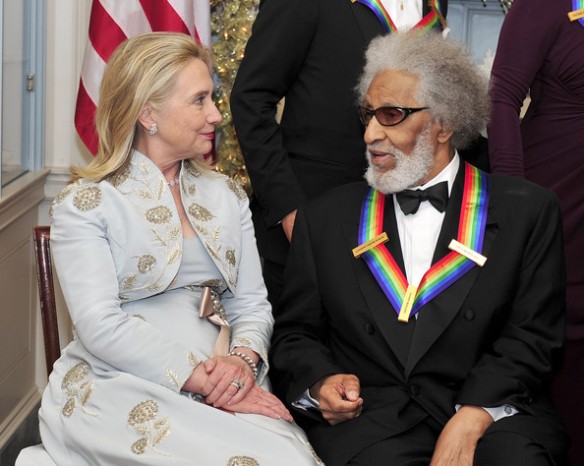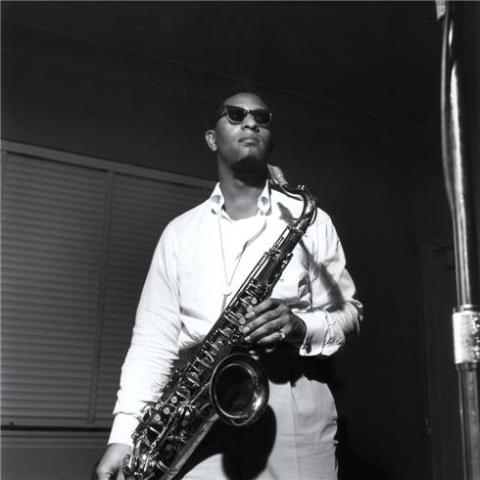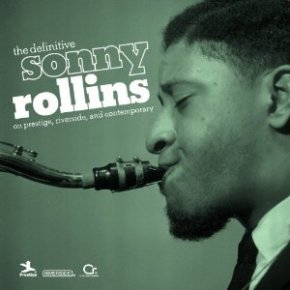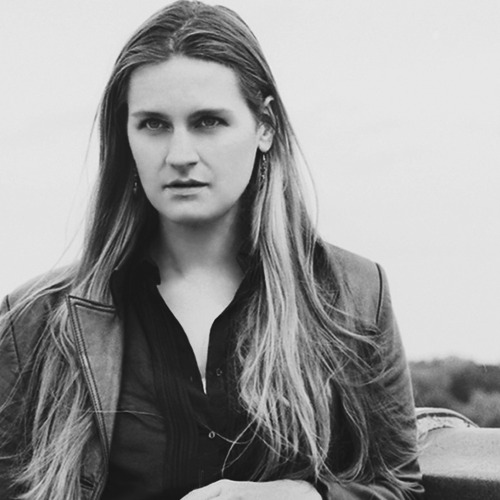The title of this piece is stolen from the name of a radio show on WJCT-FM, 89.9 in Jacksonville, Florida. “Lost In the Stacks” is hosted by Matthew Moyer and Andrew Coulon, two of the librarians at the Jacksonville Public Library downtown. The show revolves around music that can be found in the library’s collection, and I was fortunate to be invited as a guest one week in May 2012, as we previewed the Jacksonville Jazz Festival. I’d intended for this to have been online by then, to supplement the material discussed on that broadcast—that did not happen, but better late than never.

SDH at the WJCT studios, May 10, 2012. (Note that I’m holding a set of drum-sticks hand-crafted and signed by the legendary drummer/teacher Von Barlow, who left them there for someone else.)
The tracks referred to here were all obtained via compact disc, and almost all of it can still be found at there. The JPL held a pretty extensive stock of vinyl records, archival-preserved, augmenting that as the CD era took flight in the 1980s. By the early-‘90s, when I first started browsing those stacks in a serious way, the library had one of the most extensive holdings of choice material to be found anywhere—be it a storefront or a private collection. And bear in mind, there was plenty to go around: WJCT had a literal ton or two of records and CDs; UNF still has an excellent collection (in part because they kept their vinyl); local record stores still thrived, and there remained solid commercial chains like Coconuts.
When Barnes & Noble opened in Mandarin, they hired saxophonist Joe Yorio to stock their music section, and he might have ended up doing the same at Borders; I always appreciated his recommendation of Coltrane’s Afro-Blue Impressions, which were the first album I’d heard by him that I loved almost as much as the singular Interstellar Space. It was at places like that where I caught up on the new stuff; at local record stores like Stripmine Records, I’d fill in the gaps of the more obscure labels and musicians—your Hat Art, Tzadik, Black Saint, Leo, Enja material. But my main sources remained the radio and the library.
Like WJCT, the JPL began divesting itself of vinyl as the century turned. I recall buying a dozen first-pressings of Glenn Gould from the library for, I think, seven dollars—since misplaced, but worth a couple hundred if ever found. The jazz stuff had already been liquidated, all for 50 cents or a buck each. But the library has nonetheless continued to thrive in the digital future, or present, whatever. A large portion of my life was spent on the second floor of the old Haydon Burns building, which housed the library’s main branch for 40 years, walking up and down the stacks, neck craned 45 degrees to the right while edging slowly sideways, scanning the discs lined up vertically, efficiently. Back then, it took about 15 minutes to look at everything once, without touching anything, which is not possible; 15 minutes really meant an hour, for practical purposes, and you couldn’t bring coffee in with you.
Now, the music collection is split—the classical stuff (which is pretty nice) is on the third floor (closer to the reference books relevant to that subject), and the rest is down on ground level. It is situated perfectly, in the back; one must walk through the jazz section to reach the Young Adults section, and that’s a good thing for the youth, because it’s their birthright, anyway. Now the CDs are lined up in such a way that you have to flip through each disc, or grab a handful at a time to scrutinize them; it takes a little more time, but you can bring coffee now. Now, as then, folks often come prompted by Bob Bednar of WJCT; his playlists are some of the best ever, anywhere. Everyone has their favorites—stuff they heard there that might have otherwise gone unheard for years, if not forever. The web has facilitated a much faster route to learning about jazz, but there is nothing more holistic than a good public library, and Jacksonville is lucky to have a very good one. My picks (randomly listed) would include:
Charlie Christian, “Waiting On Benny”: Charlie Christian wasn’t the first great jazz guitarist in history—there was Eddie Lang, Les Paul, Freddie Green, Django Reinhardt, Oscar Aleman and others. He was not even the first to electrify the jazz guitar; he was, however, the man who made it stick. He was a game-changer in every aspect of his short career. The library doesn’t have much of his stuff—not the epic take of “Topsy” from Minton’s, nor his sessions with Lester Young—but his run with Benny Goodman’s sextet is well-documented. The high point was, in fact, an afterthought, hence the title: the leader was late, so the remaining five jammed out for five minutes until he showed up. It’s one of the greatest examples of small-group jazz in the immediate pre-war era, ruthlessly swinging the 4/4.
Lennie Tristano, “Turkish Mambo”: The music of Lennie Tristano was a revelation for me from the very first second, as it remains. The library has a CD of Rhino’s repackaging of two Tristano records made for Atlantic Records about 50 years ago. His was a very mathematically precise sort of jazz; he trained Lee Konitz, Warne Marsh, Billy Bauer and Sheila Jordan, among others, and was friends with people like Charles Mingus, Max Roach and George Russell. I was a big Anthony Braxton fan, and I’d gotten a copy of an album of Tristano songs he did from the late great Stripmine Records (its second incarnation, in Five Points). So I grabbed the Tristano disc, which contains some of the most sublime piano music you’ll ever heard. Folks who say the man played without feeling are delusional. On the first album he plays around with tape-speed, speeding-up and slowing-down certain tracks for effect; the second is straight-ahead solo piano. “Turkish Mambo” is a masterpiece—Tristano overdubs three (or four?) tracks of himself, each in a different time signature. Multi-layered, but seamless. Even the metronome swings!
Sidney Bechet, “The Sheik of Araby”: I remember wondering why the library would bother to have two copies of an old Bluebird compilation of tracks by a man largely unknown outside of musicians and critics—but then I heard it, and understood. Bechet is one of the great characters in jazz, and the comp cut a wide swath, leading off with the definitive version of “Maple Leaf Rag”. The track cited here features Bechet overdubbed on all the instruments using the primitive technology of the monaural era, literally cutting new tracks onto the disc, step-by-step. Any mistakes he made could not be fixed, so he didn’t make any. This was the beginning of so much of what we take for granted, in terms of how music is made today.
Sidney Bechet, “Sweet Georgia Brown”: Fast-forward 17 years, and Bechet is in France, a leader of the vibrant expat jazz scene in Europe. Bechet would be dead in a year, but this track, recorded live in Paris, shows that he retained his absolute mastery of the soprano saxophone until the very end. Never has this tune been swung at a faster tempo, never were more notes stacked against the harmony; it was the intersection of Bechet’s NOLA roots and the modernism he spawned. The credible solos of trumpet, trombone and piano are just scenery—the song belongs to Bechet, and drummer Francois “Moustache” Gallipedes.
Django Reinhardt, “Blues For Barclay”: When one speaks of jazz in Paris, thoughts go immediately to the gypsy who changed the game singlehandedly—literally. In 1947, Django Reinhardt brought his quintet into the studios of Blue Star Records and made his first serious recordings on electric guitar. He’d risked death by continuing to perform in occupied France during the war, caught the bop bug, came to New York and was basically rejected by the modernists; his sound was too soft, too dependent on syncopation, too acoustic to be heard in a bop setting. So he came back to Paris with a chip on his shoulder, haunted by not having gotten to assert himself as the rightful heir to Charlie Christian, and you can hear it in damn near every note he played for the remaining six years of his life. The CD Peche ala Mouche collects the cream of electrified Django from 1947-53. To this day, it remains the most slept-on aspect of the man’s legacy, and the CD is out-of-print; I was lucky enough to cop a disc of the 1947 stuff in Chicago, and some of the rest is on YouTube. The song mentioned above was written for Eddie Barclay, who produced the session and was, overall, an invaluable supporter of jazz in Europe, and European Jazz as well. Note the presence of silky clarinetist Hubert Rostaing and Andre Jourdan, one of three amazing French drummers who put in work on these sessions. This is the sound of a man playing for his life, and succeeding.
Larry Coryell/Elvin Jones, “Stiff Neck”: Even five years after first hearing this, it’s still usually the first thing I listen to in the morning; it’s like orange juice for your ears. Elvin Jones was bulletproof for years; his run with the Coltranes (John and Alice) cemented him as the kind of drummer who could do anything—trios with Sonny Rollins, orchestras with Gil Evans, the Pawnbroker soundtrack with Quincy Jones, whatever. He could show up in a movie and just randomly solo in a cowboy outfit, or run through 10-minute fusion workouts in a mesh t-shirt, white leather shoes and disco pants, and it was all good.
Lionel Hampton/Gene Krupa, “Air Mail Special”: It would be impossible to pick one person as my favorite jazz musician ever, but if I were pressed I’d defer to Krupa, since my studies of jazz music initially began as a quest for Gene Krupa records. Damian Lee sold me a Columbia repackaging of Krupa’s epic post-war trio, and it was off to the races. A common fallacy holds that Swing Era icon Krupa, who was in the 1930s the go-to guy for both Benny Goodman and George Gershwin, failed to adapt to post-war modernism, that bop left him in the dust. Untrue. While he could never be construed as a bebopper proper, the man carved his own highly relevant path through that era. Gene Krupa’s 1950s recordings are exceptional.
Sonny Rollins, “What Is This Thing Called Love?”: I’ll be honest—the music of Sonny Rollins took a while to grow on me. I became familiar with his work first through connection to Max Roach, who co-led the quintet with Clifford Brown where Rollins first became a big name in jazz. Rollins’ solo career had already begun before Brown, Richie Powell and their wives were killed in a car accident in summer 1956, but it really began in earnest as well after that; he and Roach both emerged from that tragedy as different, better musicians. Some of their best work was done together in the subsequent two years: Max Roach +4, Jazz In ¾ Time, Saxophone Colossus, The Freedom Suite. All this was nice, and moreso later, but for me what really set me straight about Sonny Rollins’ genius was his awesome 1957 double-album A Night At the Village Vanguard, which is arguably the best recording ever made at that historic NYC establishment. (Similar arguments can be made for the albums made there by John Coltrane and Bill Evans, both of which were made four years after Rollins’. The Cole Porter standard, which is taken full-bore for nearly 15 minutes, also marks one of the first real displays of Elvin Jones’ genius as a drummer. In the mid-50s, Rollins got to work with Roach, Shelly Manne and Art Blakey, among others, but it’s Jones who stands out as maybe the most versatile jazz drummer ever. The whole album is great, but it starts on the best foot possible.
Chick Corea, “Matrix”: Blue Note’s Best of Chick Corea compilation features highlights of his run fronting mostly acoustic trios for the label. I’m not the biggest fan of his stuff, but I like that era, and “Matrix” (from the 1968 album Now He Sings, Now He Sobs) is one of my favorite piano trio recordings ever. Much of the credit is due to his colleagues, bassist Miroslav Vitous and drummer Roy Haynes.
Machito, “Tanga”: The library once had a Verve CD entitled “The Original Mambo Kings” (taking off from the movie released around that same time in the 1990s), and it remains my favorite Latin-Jazz album ever, even though I haven’t heard it in 15 years. A lot of material would just disappear from there, and this was one of them. I don’t really blame them, because it was a great album that, like Peche A La Mouche, is ridiculously hard to find even now, let alone back in the days of special-orders. Still though, they could have just taped it, and not robbed all the rest of us of its pleasures.
Don Byas/Slam Stewart, “I Got Rhythm”: I’d heard a little Slam Stewart’s stuff with Slim Gaillard, whose nonsensical “Vout” style of slang reportedly remained a favorite with the Reagans well into their dotage. Stewart was known for vocalizing along with his with upright bass, sounding much like a bow being dragged across the low strings, creating its own sort of harmony alongside the string-plucking. It was an acquired taste, one that frankly didn’t resonate with me most of the time. But there were two occasions when Slam Stewart was The Man, and this five minute duet with pioneering bop tenorman Don Byas (who can also be heard on the Charlie Christian bootleg sessions) was one of them. The other was a gloomy, ethereal solo version of “Angel Eyes” (written by Matt Dennis, and old running buddy of my old friend, the late great Robert Eskew, whom I met through Alan Justiss).
Gil Evans Orchestra, “La Nevada”: Having noted the supreme versatility of Elvin Jones earlier, here’s another example. Out Of the Cool (Impulse!, 1961) was the greatest Gil Evans album; the man best-known for arranging Miles Davis’ big-band epics was a star in his own right, and “La Nevada” marks the peak of his compositional and orchestral achievements—15 minutes of swirling, throbbing, pulsing perfection from an all-star band driven by Jones, with some assistance from Dizzy Gillespie alumnus Charlie Persip. (Incidentally, the two also turn up together, along with Art Blakey and Philly Joe Jones, on the impossible-to-find Gretsch Drum Night At Birdland album.)
Turtle Island String Quartet, “Milestones”: In the 1980s, Turtle Island String Quartet took jazz to new levels by arranging a number of classic tunes for their group. Songs like “A Night In Tunisia” and “On Green Dolphin Street” not only opened the door to new perceptions of jazz, but crucially made the classical world more accessible to my young ears—a process accelerated shortly after by Glenn Gould and Martha Argerich. Among the classic TISQ efforts of that era are their versions of Bud Powell’s “Tempus Fugit” (which is hard enough, arranged for solo piano, let alone a string quartet) and the track I consider their masterpiece, “Milestones”, a song that always lends to excitement. They played the song at a much faster tempo than the original version, and the finger-picking is just brilliant. When I got to see them perform at the Church of the Good Shepherd (as part of the Riverside Fine Arts Series), it was like a pilgrimage, and one of the best concerts I’ve ever seen.
Joe Lovano/Ed Blackwell, “Modern Man”: For me, all this music represented seismic shifts in my cultural consciousness, but almost all of it was classic material from the Swing Era on through 1950s post-bop and the broader explorations that would culminate with Free Jazz in the 1960s. If the library had a weakness, in terms of their jazz collection, it was that there just wasn’t much new stuff; it was not the place to catch up on the innovations of my own time; that’s why places like Barnes and Noble and Borders became so useful. But, as one might expect, the little bit they did have was the best. Joe Lovano’s album From The Soul (1991) was the point of a spear being thrust by a resurgent Blue Note Records into the future, and it’s one of the finest jazz albums ever recorded, in any era. It was a lineup of future hall-of-famers, most of whom had yet to make their greatest contributions to the music, and one aging legend who took that moment to make a final stand that will never be forgotten. Lovano was joined by bassist Dave Holland, who went on to lead arguably best large jazz group on the planet, and pianist Michel Petrucciani, whose legacy as the heir to Bill Evans’ absolute dominance of jazz piano remained unimpeached until his premature death in 1999. The opening track, “Evolution”, catches the whole band on fire, but neither Holland nor Petrucciani appear on “Modern Man”. Instead, that track is a duet between Lovano and drummer Ed Blackwell, who was probably best-known for his work with Ornette Coleman, Don Cherry, Archie Shepp and Mal Waldron.
Dinah Washington, “Cry Me A River”: No one sounded like her—maybe the purest, most resonant voice in the entire history of music. Like all the great singers, hers was an utterly unique vocal instrument. Dinah Washington died way too young, but the stuff she left behind will last until the end of time, starting with “Cry Me A River”. It defies my ability to explain why’s it such a game-changer.
sheltonhull@gmail.com; May 30, 2012








